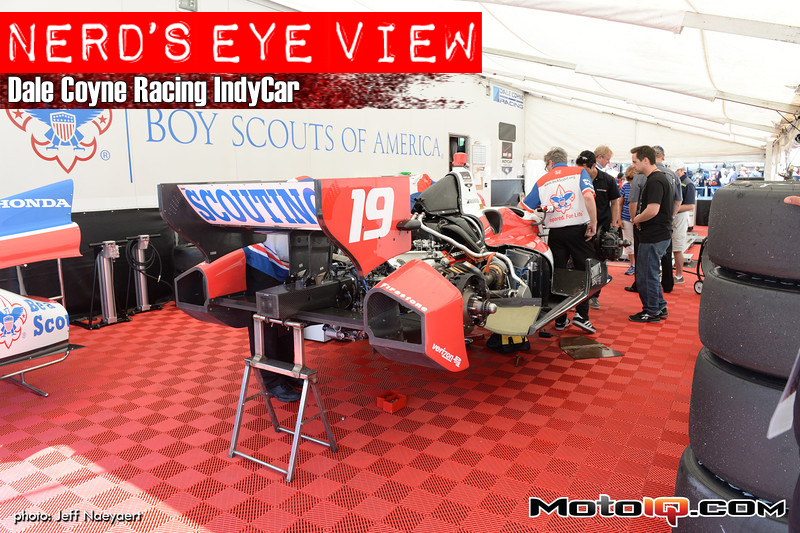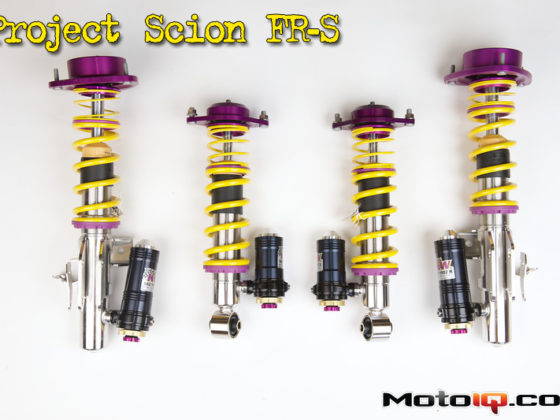,
 The lower control arm mounting point shows the suspension joints are standard heim joints. The mounting bracket has a little arrow on it indicating the direction to be mounted and there appear to be two mounting location options. One thing I learned that I found very interesting is that the car’s wheelbase can be changed to suit different tracks.
The lower control arm mounting point shows the suspension joints are standard heim joints. The mounting bracket has a little arrow on it indicating the direction to be mounted and there appear to be two mounting location options. One thing I learned that I found very interesting is that the car’s wheelbase can be changed to suit different tracks. The front suspension uses the typical inboard mounted dampers with bell cranks and pushrod actuation. The dampers have been removed, but they attach to the bell cranks at the innermost holes and also to the mounting brackets attached to the rear of the compartment.
The front suspension uses the typical inboard mounted dampers with bell cranks and pushrod actuation. The dampers have been removed, but they attach to the bell cranks at the innermost holes and also to the mounting brackets attached to the rear of the compartment. The front suspension is also designed for a third spring setup; however, the team chose not to run one on this particular track. Again, you can see the screws in the central bracket used to limit the movement of the bell cranks and therefore droop travel. The little blue cylinders are linear potentiometers to measure suspension movement. Looking down the hold at the front of where the third spring mounts, you can see the adjustable blade type anti-roll bar. Notice the pushrod attached to the bell crank is marked with a ‘+’, ‘-‘ and direction arrow; little labels like this help make sure everything is installed correctly. Also check out the clear tape used to cover up the holes for the screws on the carbon fiber control arm covers. Reducing aero drag anywhere you can is critical. The tape probably helps keep sand and dirt from getting into the top of the screws too, making maintenance easier.
The front suspension is also designed for a third spring setup; however, the team chose not to run one on this particular track. Again, you can see the screws in the central bracket used to limit the movement of the bell cranks and therefore droop travel. The little blue cylinders are linear potentiometers to measure suspension movement. Looking down the hold at the front of where the third spring mounts, you can see the adjustable blade type anti-roll bar. Notice the pushrod attached to the bell crank is marked with a ‘+’, ‘-‘ and direction arrow; little labels like this help make sure everything is installed correctly. Also check out the clear tape used to cover up the holes for the screws on the carbon fiber control arm covers. Reducing aero drag anywhere you can is critical. The tape probably helps keep sand and dirt from getting into the top of the screws too, making maintenance easier. Here is a direct view of the adjustable blade type anti-roll bar. Universal sweat bands are used on the fluid reservoirs. And yes, that is a lot more wiring required for things like the two pressure transducers in the back attached to the brake master cylinders keeping tabs on front and rear brake pressures.
Here is a direct view of the adjustable blade type anti-roll bar. Universal sweat bands are used on the fluid reservoirs. And yes, that is a lot more wiring required for things like the two pressure transducers in the back attached to the brake master cylinders keeping tabs on front and rear brake pressures. A few of those wires probably connect to these black boxes. ECUs need cooling too and the black cases have finned heat sinks fed air by a cutout in the carbon fiber duct feeding the big heat exchanger in the left side pod. Transistors don’t like a lot of vibrations, so the ECU case is mounted with rubber isolators to help damp out the vibrations from the car.
A few of those wires probably connect to these black boxes. ECUs need cooling too and the black cases have finned heat sinks fed air by a cutout in the carbon fiber duct feeding the big heat exchanger in the left side pod. Transistors don’t like a lot of vibrations, so the ECU case is mounted with rubber isolators to help damp out the vibrations from the car.


